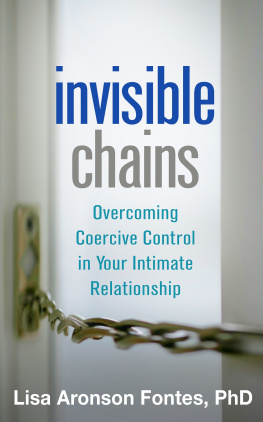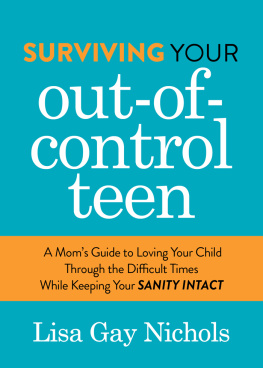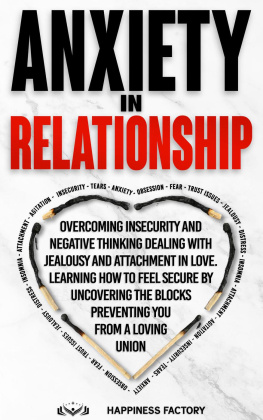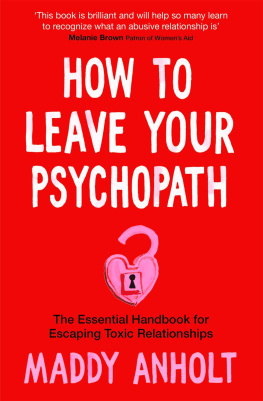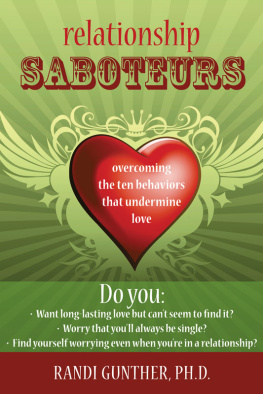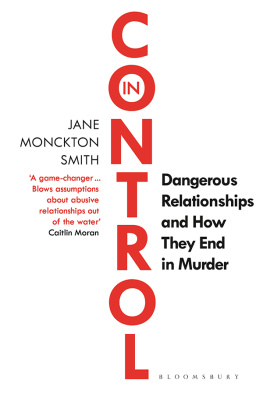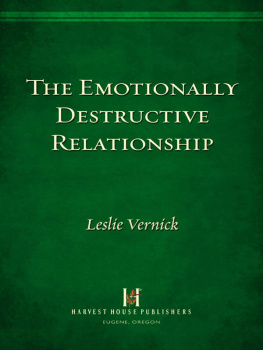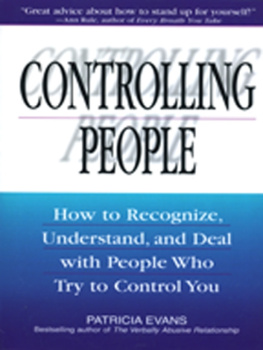I wish Id had this book in my youth, when I was the victim of coercion that whittled away at my self-esteem. This book should be in every womens center, police station, and therapists office. It cuts through the jargon, gets to the heart of the matter, and provides tools of liberation.
Magdalena Gmez,
author of Shameless Woman
The first comprehensive guide to overcoming coercive control. Dr. Fontes provides simple tools to assess your own or a loved ones relationship and offers practical steps to getting free, illustrated with real-life stories. The writing is sharp and evocative and the research is impeccable. A pathbreaking work.
Evan Stark, PhD, MSW, Professor Emeritus,
Rutgers University School of Public Affairs
Dr. Fontes makes the dynamics of coercive control understandable to everyone. In plain language and with clear examples, she describes the tactics of domineering individuals and their effects on victims. Dr. Fontes is particularly thoughtful about including diverse couples and families. After reading this book, no one will be able to ask, Why does she stay?
Juan Carlos Aren, Director, National Latin@ Network
for Healthy Families and Communities
This book reveals hidden dimensions behind relationships where one partner is controlled by the other. Dr. Fontes explains the dynamics of coercive control and deciphers the pattern so we can all understand it. Read this book and reclaim your life.
Rabbi Efraim Eisen, marriage, family,
and child therapist, Amherst, Massachusetts
This book is gripping and nuanced. It will be extremely helpful to anyone grappling with issues of coercive control. As a therapist with decades of experience, and a person who has been in coercive relationships, I learned a great deal. The stories of women and men from wide-ranging backgrounds pulled me in deeply. Complex, profound ideas are expressed in easy-to-read language. A must-have resource!
Janine Roberts, EdD,
past president, American Family Therapy Academy
Fontess writing is clear and vividly illustrated with real-life stories from her decades of work helping abuse victims become survivors. Invisible Chains is a hopeful book that shows a way out of coercive control relationships and illustrates the promise of healing and recovery.
Jeffrey L. Edleson, PhD,
Dean and Professor, School of Social Welfare,
University of California, Berkeley
This powerful and informative resource delivers essential information in a nonjudgmental and sensitive manner. People who work in the legal and criminal justice systems need this book to help keep victims and their children safe. The book is easy to read, but in no way simplistic. I will be placing a copy of this book in our office library as a resource for our attorneys and advocates.
Ismael R. Ozanne, Dane County
District Attorney, Madison, Wisconsin
For Professionals
Child Abuse and Culture:
Working with Diverse Families
Interviewing Clients across Cultures:
A Practitioners Guide
invisible
chains
Overcoming
Coercive Control
in Your Intimate
Relationship
Lisa Aronson Fontes, PhD

THE GUILFORD PRESS
New York London
Epub Edition ISBN: 9781462520640; Kindle Edition ISBN: 9781462520657
2015 The Guilford Press
A Division of Guilford Publications, Inc.
370 Seventh Avenue, Suite 1200, New York, NY 10001
www.guilford.com
All rights reserved
The information in this volume is not intended as a substitute for consultation with healthcare professionals. Each individuals health concerns should be evaluated by a qualified professional.
Except as indicated, no part of this book may be reproduced, translated, stored in a retrieval system, or transmitted, in any form or by any means, electronic, mechanical, photocopying, microfilming, recording, or otherwise, without written permission from the publisher.
Last digit is print number: 9 8 7 6 5 4 3 2 1
Library of Congress Cataloging-in-Publication Data
Fontes, Lisa Aronson.
Invisible chains : overcoming coercive control in your intimate relationship / Lisa Aronson Fontes.
pages cm
Includes bibliographical references and index.
ISBN 978-1-4625-2024-4 (paperback) ISBN 978-1-4625-2035-0 (hardcover)
1. Dominance (Psychology) 2. Control (Psychology) 3. Interpersonal relations. 4. Intimate partner violence. 5. Intimidation. I. Title.
BF632.5.F66 2015
158.24dc23
2014048835
For my children, Marlena, Gabriel, and Ana Lua,
with love and gratitude
Contents
Purchasers of this book can download and print a larger format of the .
This book discusses relationships where one person dominates and intimidates another in an abusive process called coercive control. These relationships usually are not all bad. Coercive control often feels like love. Passion and companionship can exist alongside threats, punishment, isolation, and even physical violence.
Coercive control often feels like love.
Coercive control is a special kind of torment because it happens within a relationship of strong personal bonds, hopes, and dreams. Coercive control continues over a period of months, years, or decadesunlike a one-time assault by a stranger, for instance. Coercive control wears down a victims autonomy and sense of well-being over time. Between the direct acts of control and possibly violence, a victim lives in fear. The distress is ongoing, even during periods that seem calmer.
Women can certainly be as bossy and jealous as men. However, for reasons discussed later, coercive control almost always involves a man using a range of tactics to hurt, threaten, degrade, and isolate his female partner. Coercive control does sometimes involve a woman as the oppressor and a man as the victim. It can occur in relationships involving gay, lesbian, bisexual, and transgender people as well. This book is designed to assist all people who are controlled by their partners, whatever their culture, age, gender, or sexual orientation..
This book includes both everyday and extreme examples. Some of the subtle forms of coercive control can be hard to detect and may feel like love when they first appear. For instance, a woman may feel flattered that her partner wants to be with her at all times: driving her to work, meeting her for lunch, and accompanying her when she shops. Family and friends may commend her for finding such an attentive mate. He insists he is motivated by love and concern for her safety, so she pushes aside the discomfort she feels about never having time alone. His frequent texts during the day sometimes interfere with her work. On several occasions he grows angry because she doesnt respond promptly to his calls or texts, or because she spends time with a friend without asking him first. Then he begins to check her cell phone and upsets her with his constant questions. While no one of these acts in itself appears overly alarming, they build up over time. The woman becomes less and less free.
In contrast to these ordinary acts, the more extreme examples included in this book are obvious signs of abusive control and may prompt readers to ask, Why would anyone put up with that? explains the dynamics that keep women in relationships where they are controlled and victimized.
The examples in this book are all based on real situations, although I have changed identifying details to protect privacy. They are drawn from my work as a psychotherapist, community activist, workshop presenter, and researcher, as well as personal conversations in many settings. Some of the examples come from my own experience as a former victim of coercive control.
Next page
